

Jon Clements, Editor
Current degree day accumulations
2014 New England Tree Fruit Management Guide Available
| UMass Cold Spring Orchard, Belchertown, MA |
14-April |
| Base 43 (SkyBit) | 118 |
| Base 50 (NEWA) | 61 |
Current bud stages. April 14, 2014, UMass Cold Spring Orchard, Belchertown, MA
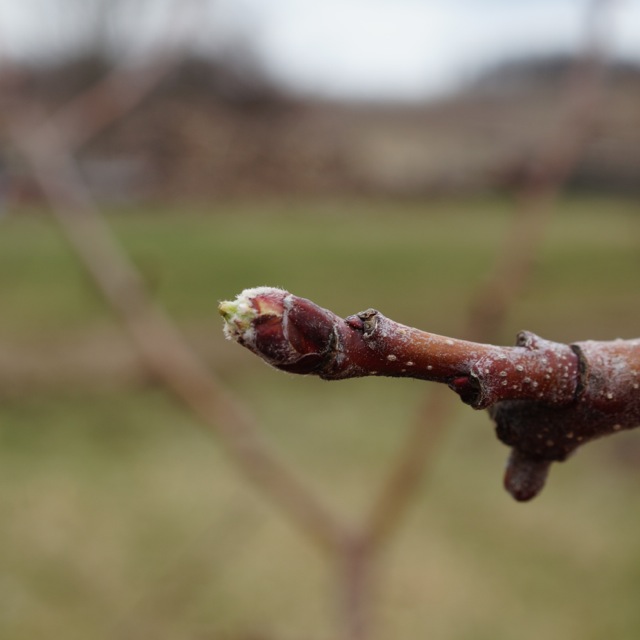 |
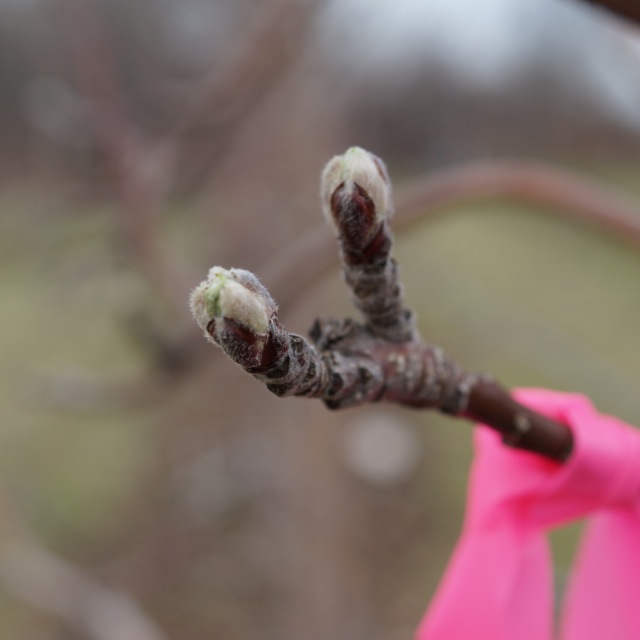 |
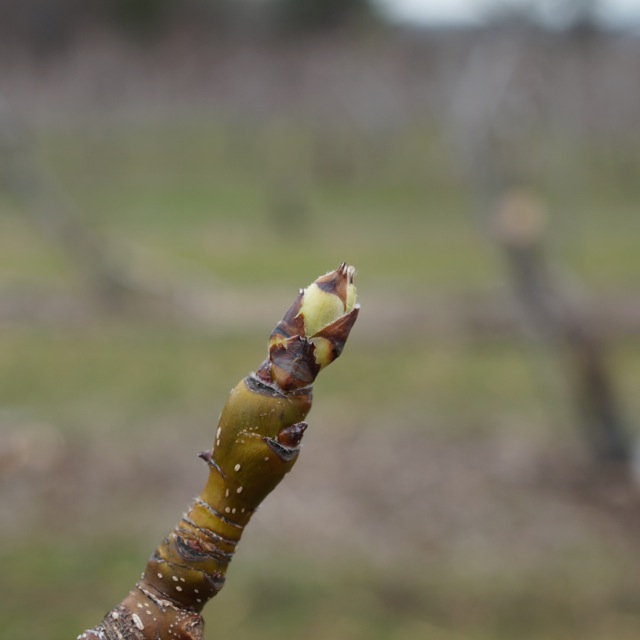 |
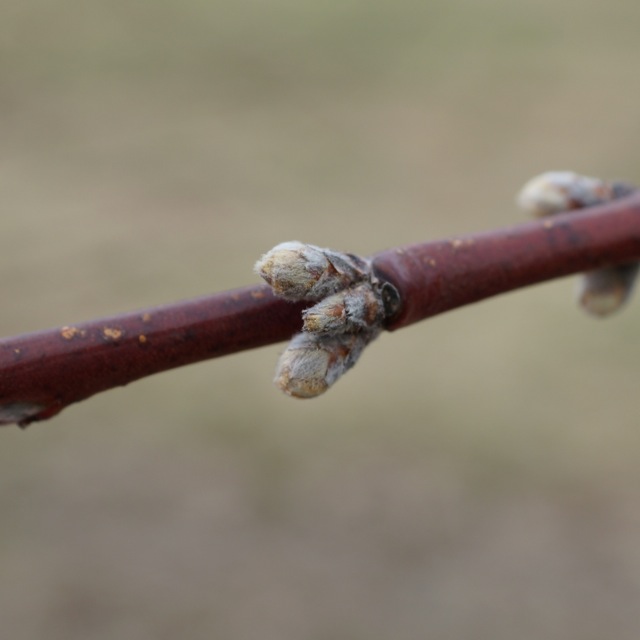 |
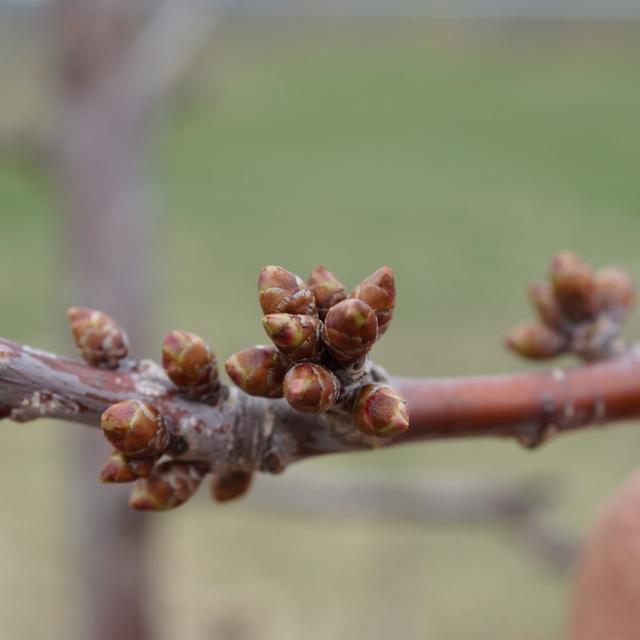 |
Honeycrisp apple early green tip |
McIntosh apple green tip |
Kosui Asian Pear swollen bud |
PF-14 Jersey peach early swollen bud |
Rainier sweet cherry early swollen bud |
| Coming events | Degree days (Base 43) |
| Green fruitworm 1st catch | 97-213 |
| Pear psylla adults active | 31-99 |
| Pear psylla 1st oviposition | 40-126 |
| Rebanded leafroller 1st catch | 110-178 |
| Spotted tentiform leafminer 1st catch | 113-213 |
| Rosy apple aphid nymphs present | 134-244 |
| McIntosh green tip | 97-145 |
15-April, 2014 Fruit Twilight Meeting at Red Apple Farm, 455 Highland Ave., Phillipston, MA. 5:30 to 7:30 PM. 1 pesticide credit will be offered. Light dinner will be served. Orchard walk, current orchard management updates, SWD and BMSB update. $25 meeting fee ($20 for MFGA members.) Contact: Jon Clements, 413-478-7219. Pre-registration is not necessary.
17-April, 2014 Fruit Twilight Meeting at Steere Orchard, 155 Austin Ave., Greenville, RI. 5:30 to 7:30 PM. 2 pesticide credits will be offered. Light dinner will be served. Wes Autio (UMass) and Win Cowgill (Rutgers) will demonstrate grafting (to-working) of apple trees and there will be an orchard management (insect and disease) update. $20 meeting fee for other than RIFGA members. Contact: Jon Clements, 413-478-7219. Pre-registration is not necessary.
This Healthy Fruit is only going out to PAID subscribers (as of 4/15/14) only. If you are not getting it, and you are seeing this, you need to go to the UMass Extension Bookstore and renew your subscription ASAP. (You can also get the subscription form here.)
Everybody is probably fretting about scab with this rain and barely at green tip. If you had pretty much a scab-free orchard last year, relax. Spore maturity is very low, green tissue is sparse, not much risk for infection. (Of course I could be wrong...:-)) If you had applied a copper spray prior to green tip, you are golden. But if you had a pretty scabby orchard or orchard block last year, I'd be a little more worried and would want to be covered up with a fungicide (copper or EBDC) just prior to now. If you don't get anything on before (or during) this rain, plan on going out and spraying fungicide with kickback ASAP after the rain ends. Vangard, Scala, and Syllit would all be good choices and have 48-72 hours of post-infection activity depending on the temperature.
I'd like to point out that even athough Dr. David Rosenberger has officially retired from Cornell, he is maintaining a modest presence in the Hudson Valley while he continues to pursue things that interest him. (I don't know if he plays golf?) I have known Dave for a long time, and although has always been active in e-mail, he generally has come across as quite skeptical (curmudgeon?) of new technology! So, I am quite pleased now that Dave has joined the "blogosphere" and started his own blog: http://blogs.cornell.edu/plantpathhvl/observations-2014/. You should bookmark it and keep track of it, you will be hearing from the best. Thanks Dave. JC
A collaboration of tree fruit specialists in all six New England states, and with Cornell University, the 2014 New England Tree Fruit Management Guide (NETFMG) is a must-have for all commercial orchardists. The 2014 NETFMG is 276 pages and includes chapters on: Integrated Crop & Pest Management; Organic Tree Fruit Production in New England; Pesticide and Sprayer Information; Characteristics of Crop Protectants Used on Tree Fruits; Disease, Insect, Weed, Wildlife, and Nutrient Management; and specific spray management recommendations for Apples, Pears, Cherries, Peaches and Nectarines, Apricots, and Plums and Prunes. The 2014 NETFMG is available for purchase for $55 (plus shipping) on the UMass Extension Bookstore, http://umassextensionbookstore.com/. The 2014 NETFMG will also be available for sale at Fruit Twilight Meetings. (But supply is limited.)
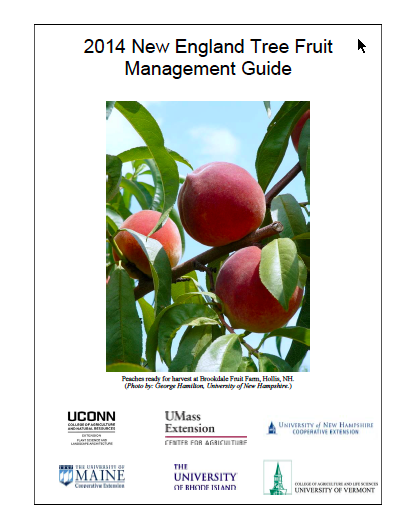
Really not much going on until the weather gets settled. Don't rush your oil application until we get past the upcoming "cool" spell. Meanwhile, maybe everything will drown in the rain and/or freeze? JC
New Fungicides: Balancing Resistance Management and Disease Management During Primary Apple Scab Season
Daniel Cooley, UMass Amherst Stockbridge School of Agriculture
We continue to have have new fungicide products on the market, based around a new chemistry, the succinate dehydrogenase inhibitors, or SDHI’s. These fungicides are in their own resistance group, 7. There are several new fungicide products registered for apples based around these materials, including Fontelis, Luna Sensation, Luna Tranquility and Merivon.
Three of these new products are pre-mixed combinations of an SDHI with another type of fungicide. Only Fontelis is not pre-mixed. The companies that produce the pre-mixes market them as better for resistance management and covering a broader spectrum of diseases than the SDHI alone. Pre-mixing also can, in my opinion, waste fungicides. They may even lead to problems, as both the SDHIs and the fungicides they are mixed with are site-specific. That means there’s a relatively high risk that resistance to either fungicide can develop. Theory says that putting two fungicides together, even two site-specific fungicides, decreases that risk. I agree with the theory in principle, but I’m not aware of actual data that backs that idea up. I think it would be more prudent to mix a site-specific fungicide with a multi-site protectant, specifically captan or one of the EBDCs (mancozeb or Polyram). There has never been a case of apple scab resistance to multi-site fungicides to my knowledge.
Fontelis, however, should not be tank-mixed with captan. There have been reports of phytotoxicity caused by the combination, and labels in some other countries contain the warning that Fontelis contains mineral oil, and therefore the same cautions used with oil applications should be used with Fontelis. That is, don’t apply captan plus Fontelis. Growers should consider eliminating captan use around petal fall and first cover if they are applying other chemicals such as thinners, insecticides or adjuvants that can interact with it to produce russet or other phytotoxic damage. Instead, use an EBDC.
Two of the pre-mixes, Luna Sensation and Merivon, are combined with a strobilurin. Strobilurin fungicides are also called QoI fungicides, for Quinone outside Inhibitors. They are in fungicide resistance group 11. Luna Sensation is an SDHI fungicide combined with the active ingredient that’s in Flint. Merivon is a combination of an SDHI and the active ingredient in Pristine. Strobilurin-resistant populations of the apple scab pathogen have been identified in Michigan and New York, and scab from a few orchards in Massachusetts and other parts of New England have been identified as shifting towards resistance strobilurine resistance. Because of this, I recommend limited use of Flint or Sovran mixed with a protectant fungicide, captan or an EBDC. I also recommend a protectant be mixed with Luna Sensation or Merivon to manage resistance.
Luna Tranquility is mixed with an anilinopyrimidine, the active ingredient in Scala. Anilinopyrimidines are also called APs, and are in resistance group 9. Scala is a reasonably good fungicide against scab prior to pink, but as temperatures warm, and particularly once fruit has formed, it is not as effective as most other scab fungicides. With these issues in mind, the wise thing to do, in my opinion, is mix a multi-site protectant fungicide, captan or mancozeb, with these fungicides if you’re going to use them. It reduces the risk of failure and resistance development.
The strobilurins and the AP in the pre-mix SDHI products may be useful against scab at specific times, but should be used with a multi-site protectant to manage resistance. That is, three different fungicides should be used. The mixing partner with the SDHI pre-mixes puts some limits on their use, as consecutive applications of any site-specific fungicide should be avoided. In Luna Sensation, Luna Tranquility and Merivon, that means not only that consecutive applications of an SDHI should not be made, but that a strobilurin application should not follow Luna Sensation or Merivon (or vice-versa).
Because the AP in Luna Sensation is only marginally useful against scab during the pink to petal fall period, and SDHI applications should be limited to pink to petal fall, Luna Sensation is not recommended for use in these schedules.
In addition to resistance management, there are other disease issues that need to be managed beginning around bloom, most importantly rusts and powdery mildew. Where either or both of these diseases are a problem, the DMIs are the most effective choices, the SDHIs good, and the QoIs a choice only where rust is the only problem. The QoIs are not effective against mildew.
Spray Schedules for Primary Apple Scab
Because the options for apple fungicides up to first cover have become more complicated, I’ve suggested five different schedules that try to balance the many factors important to effective disease management in apples including resistance. Of course, each of these may be adjusted to particular situations. They are guidelines.
In this table (click here, print out in color, and hang on your spray shed wall!), the spray program options generally address the following situations.
Ed. note: MANDATORY DOWNLOADS BELOW, print in color, hang on spray shed wall for your reference! JC
Five Apple Scab Programs for 2013-14 (Dan Cooley, UMass Amherst)
Fungicides Apple Resistance 2013-14 (Dan Cooley, UMass Amherst)
Fungicide Resistance Management Guidelines for Apple Scab and Powdery Mildew Control in the Mid-Atlantic United States (Alan R. Biggs, West Virginia University)
See Win Cowgill's guest article on bacterial canker of cherry below. JC
Help control bacterial canker with late dormant to bud-break copper and good horticultural practices
Win Cowgill, Rutgers Cooperative Extension (with edits by Jon Clements, UMass Amherst)Bacterial canker continues to be a serious bacterial disease of both sweet and tart cherry in New Jersey as well as most other cherry production areas of the world where rain occurs. (Including Massachusetts, New York, Michigan, Oregon, Washington, Chile, Germany -- canker observed in all these places.)
Bacterial canker or bacterial gummosis of sweet cherry is caused by several Pseudomonas bacteria. This disease initially infects flower buds and spurs. It can completely kill new spurs and leaves and then move into the trunk on cherry. This is especially problematic with our new Gisela® dwarf-rootstock cherries as losing a scaffold limb or getting infection into the trunk will limit production as the tree rapidly declines.
Initiate control now with copper during the late dormant period...
I like to have two applications of copper on in the spring, the first application made right at bud swell, as a Bordeaux spray mix using copper sulfate. (Bordeaux mixture is commonly referred to as Bordeaux 10-10-100, where 10 lbs. of copper sulfate and 10 lbs. of hydrated lime are mixed in 100 gallons water final spray mixture.) If you still do not have flowers showing you can apply additional copper, as a fixed copper (I.e., commercial product such as Kocide, Champ, Badge, etc.). Do not apply copper after bud burst. Thorough coverage is important; I apply this spray as a full dilute tree row volume spray.
In our wet and humid climate in New Jersey, canker can continue to develop in lateral branches and the central leader. In some cases the cankers have grown to girdle and kill two-year wood. I have observed central leader dieback as a result. In older wood the canker looks very much like a fire blight canker in apple. In most cases the canker begins to ooze a brown to amber exudate. Under our humid conditions this disease can be very hard to control and can be devastating if control measures and proper horticultural practices are not followed. Bacterial canker is most troublesome in young plantings where it can cause loses of up to ten percent (or more) of the trees. On mature trees it can reduce yields from 10–50%.
Many growers who did not think they had bacterial canker begin to see it on three and four year old trees. Once you have it, you really need to follow our recommendations to keep it at bay. Left to it's own, bacterial canker will ruin a sweet cherry orchard if conditions are favorable for it's spread.
The source of inoculum may come from wild cherry trees in our hedgerows. Black Cherry (Prunus serotina) may be one source of inoculum for Pseudomonas during wind and rainstorms in the spring and summer months. Removal may be beneficial. Also, avoid inter-planting or new orchard establishment in the vicinity or an orchare where canker is already prevalent.
Pruning cherry so as to minimize canker...
We should avoid large, dormant pruning cuts. nstead summer prune (immediately after harvest) to minimize the impact of this disease.
Note that on trees on Gisela® rootstocks, some cuts may have to be made in the dormant stage. (This is because you need to sustain vigor in the tree.) I suggest waiting to close to bloom. Look for three days of clear sunny low humidity to begin pruning. Spray copper before starting pruning, then paint the cuts with a copper/latex paint mixture. Apply another copper spray immediately after pruning or before the next rain event.
Fact sheet...
Bacterial Canker Management of Cherry In Oregon is a fact sheet with an 11-step program to minimize bacterial canker in cherry. To my knowledge we have no resistance to copper with bacterial canker in NJ (or MA). http://extension.oregonstate.edu/wasco/sites/default/files/horticulture/IFP/Bacterial_Canker_Management.pdf
Follow me (jmcextman) on FB: https://www.facebook.com/jmcextman

UMass Fruit Advisor: http://umassfruit.com
Scaffolds Fruit Journal: http://www.nysaes.cornell.edu/ent/scafolds/
Network for Environment and Weather Applications (NEWA): http://newa.cornell.edu
Follow me on Twitter (http://twitter.com/jmcextman) and Facebook (http://www.facebook.com/jmcextman)
UMass Vegetable & Fruit IPM Network (on Facebook, http://www.facebook.com/umassipmteam)
The next Healthy Fruit will be published on Tuesday, April 22 or thereabouts, 2014. As always feel free to get in touch with any member of the UMass Fruit Team (http://extension.umass.edu/fruitadvisor/team-members) if you have questions or comments.